Organizational Behavior Challenges at Souvi Event Management Company
VerifiedAdded on 2022/10/11
|10
|2099
|13
Report
AI Summary
This report provides an executive summary of the organizational behavior challenges faced by Souvi Event Management, a new company. The analysis identifies key issues such as the lack of documented processes, unclear job roles, ineffective teamwork, and communication problems. The report delves into the root causes of these issues, including the small size of the team and the leadership style. It also discusses the importance of effective meetings, team dynamics, and professional communication. Several alternative courses of action are considered, including the implementation of autocratic leadership and increasing the organizational hierarchy. The recommended solution is to increase the hierarchy levels to allow for better job specialization and reduce the burden on existing employees. The report concludes by emphasizing the need for Souvi to address these issues to improve its business operations. References are provided for further reading.
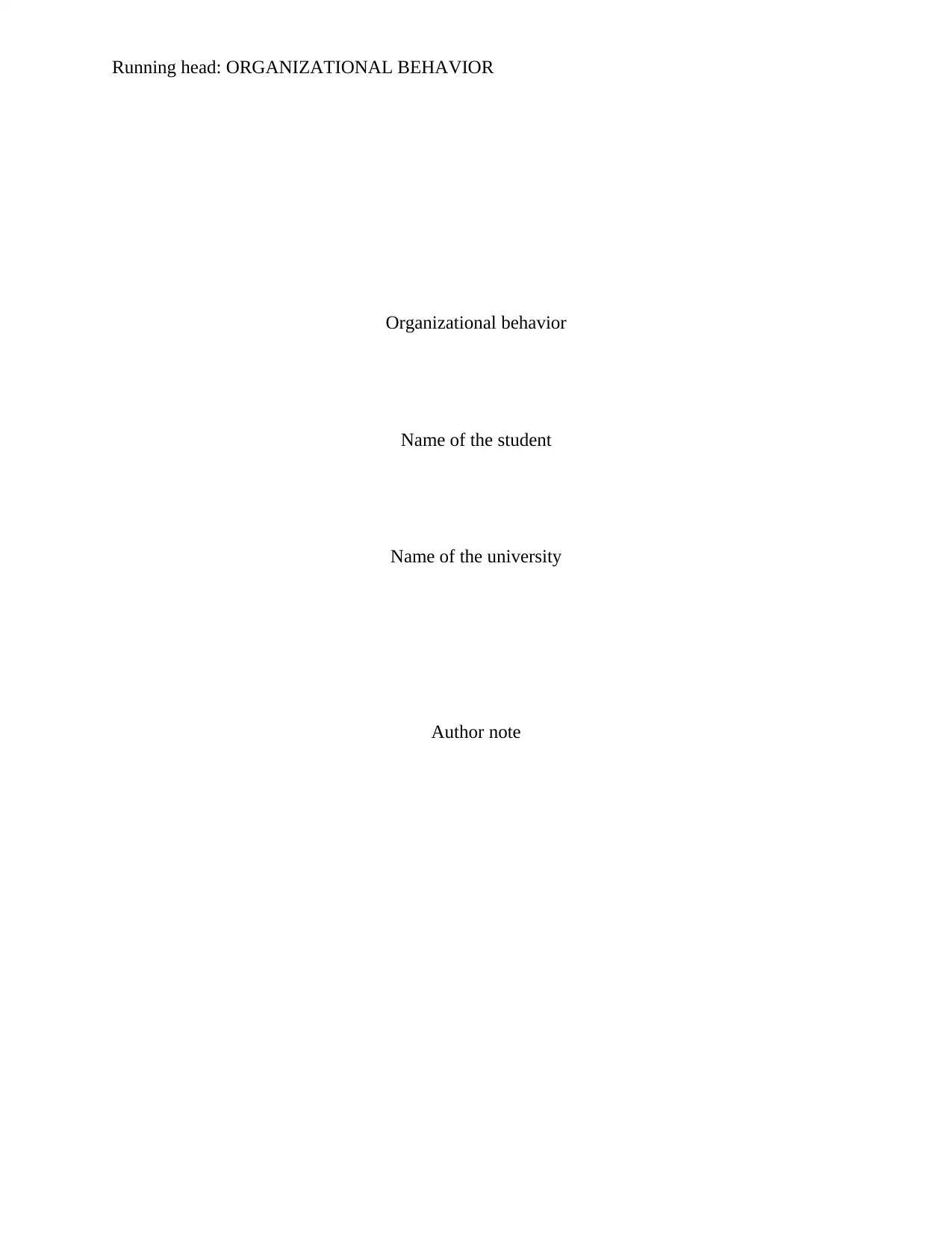
Running head: ORGANIZATIONAL BEHAVIOR
Organizational behavior
Name of the student
Name of the university
Author note
Organizational behavior
Name of the student
Name of the university
Author note
Paraphrase This Document
Need a fresh take? Get an instant paraphrase of this document with our AI Paraphraser
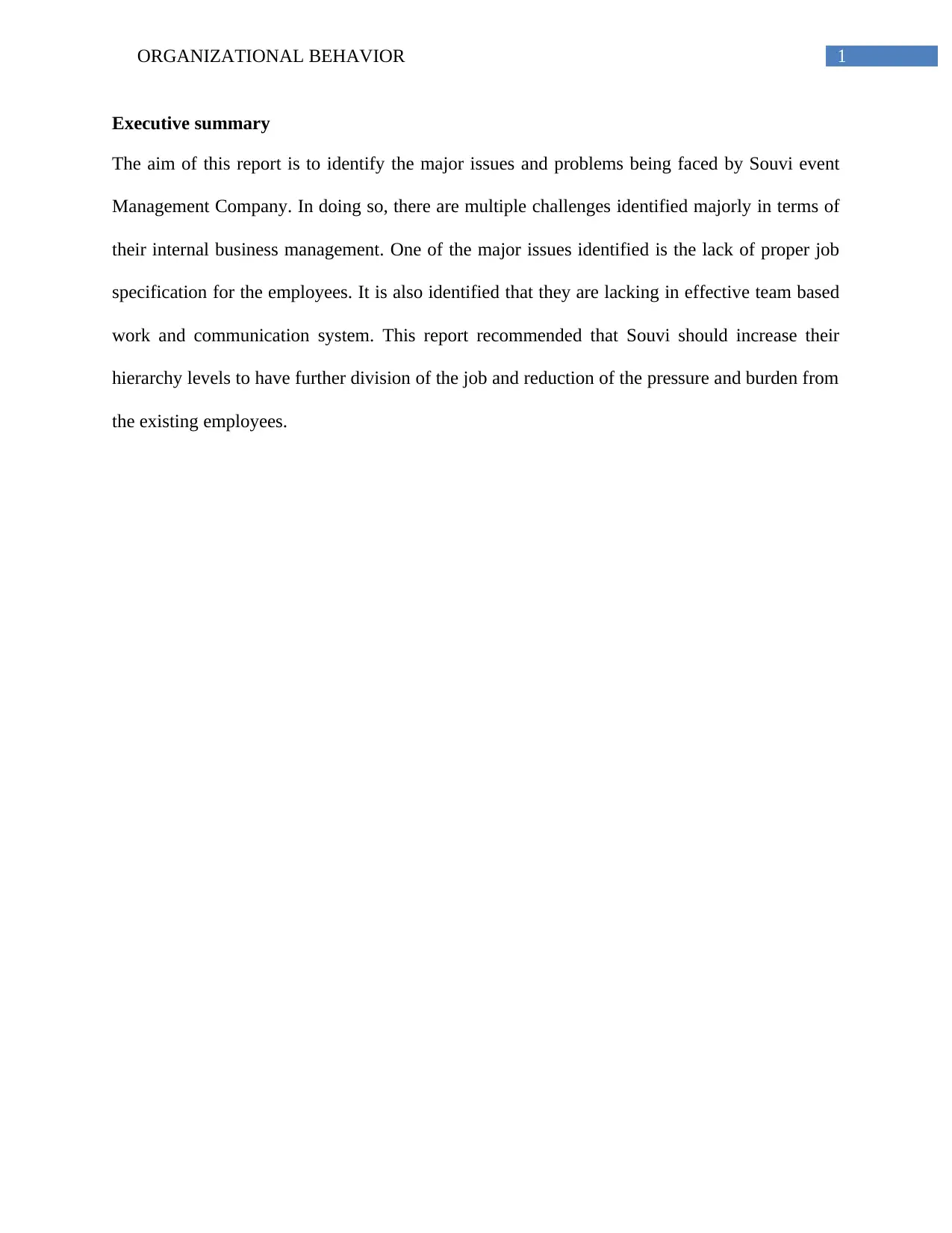
1ORGANIZATIONAL BEHAVIOR
Executive summary
The aim of this report is to identify the major issues and problems being faced by Souvi event
Management Company. In doing so, there are multiple challenges identified majorly in terms of
their internal business management. One of the major issues identified is the lack of proper job
specification for the employees. It is also identified that they are lacking in effective team based
work and communication system. This report recommended that Souvi should increase their
hierarchy levels to have further division of the job and reduction of the pressure and burden from
the existing employees.
Executive summary
The aim of this report is to identify the major issues and problems being faced by Souvi event
Management Company. In doing so, there are multiple challenges identified majorly in terms of
their internal business management. One of the major issues identified is the lack of proper job
specification for the employees. It is also identified that they are lacking in effective team based
work and communication system. This report recommended that Souvi should increase their
hierarchy levels to have further division of the job and reduction of the pressure and burden from
the existing employees.
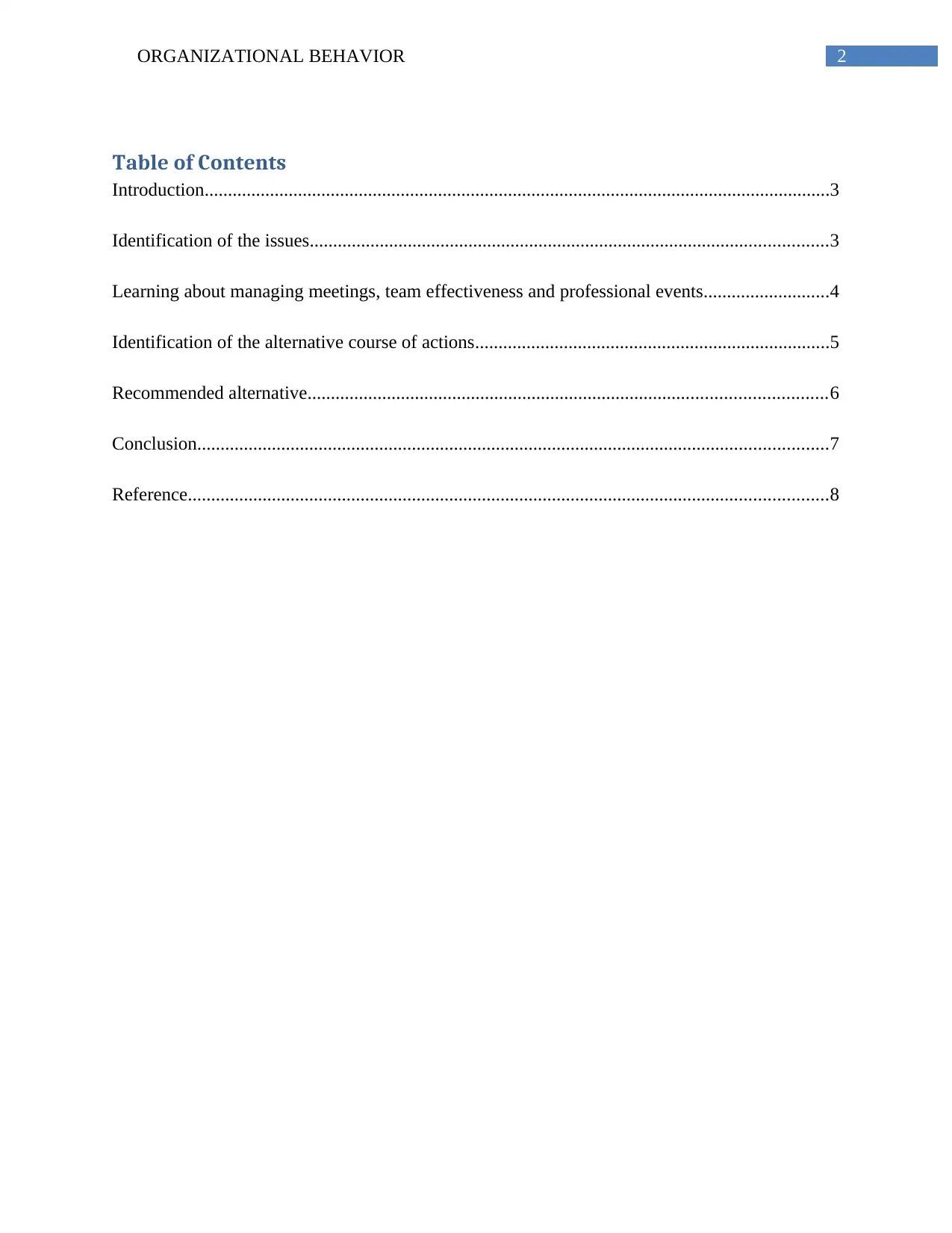
2ORGANIZATIONAL BEHAVIOR
Table of Contents
Introduction......................................................................................................................................3
Identification of the issues...............................................................................................................3
Learning about managing meetings, team effectiveness and professional events...........................4
Identification of the alternative course of actions............................................................................5
Recommended alternative...............................................................................................................6
Conclusion.......................................................................................................................................7
Reference.........................................................................................................................................8
Table of Contents
Introduction......................................................................................................................................3
Identification of the issues...............................................................................................................3
Learning about managing meetings, team effectiveness and professional events...........................4
Identification of the alternative course of actions............................................................................5
Recommended alternative...............................................................................................................6
Conclusion.......................................................................................................................................7
Reference.........................................................................................................................................8
⊘ This is a preview!⊘
Do you want full access?
Subscribe today to unlock all pages.

Trusted by 1+ million students worldwide
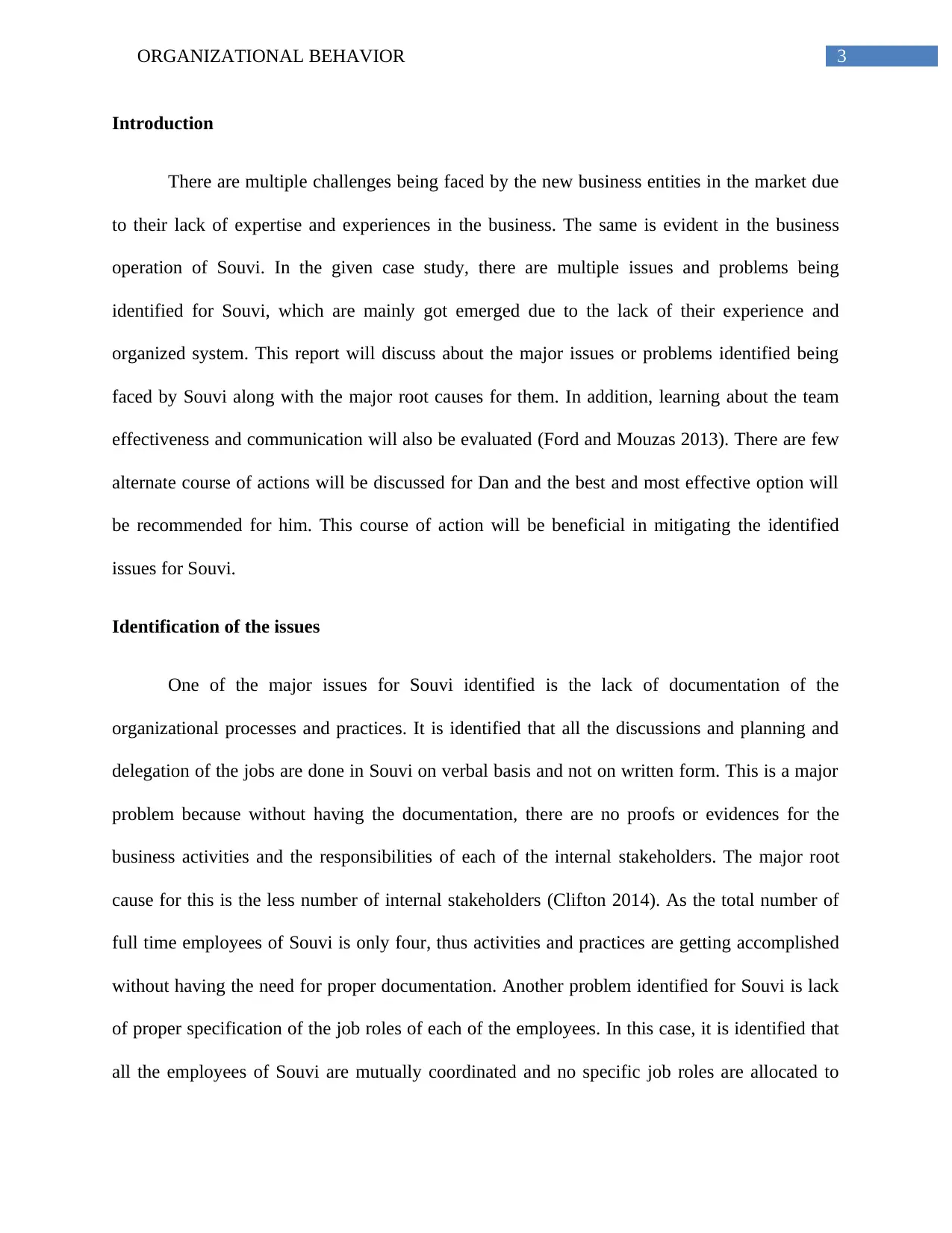
3ORGANIZATIONAL BEHAVIOR
Introduction
There are multiple challenges being faced by the new business entities in the market due
to their lack of expertise and experiences in the business. The same is evident in the business
operation of Souvi. In the given case study, there are multiple issues and problems being
identified for Souvi, which are mainly got emerged due to the lack of their experience and
organized system. This report will discuss about the major issues or problems identified being
faced by Souvi along with the major root causes for them. In addition, learning about the team
effectiveness and communication will also be evaluated (Ford and Mouzas 2013). There are few
alternate course of actions will be discussed for Dan and the best and most effective option will
be recommended for him. This course of action will be beneficial in mitigating the identified
issues for Souvi.
Identification of the issues
One of the major issues for Souvi identified is the lack of documentation of the
organizational processes and practices. It is identified that all the discussions and planning and
delegation of the jobs are done in Souvi on verbal basis and not on written form. This is a major
problem because without having the documentation, there are no proofs or evidences for the
business activities and the responsibilities of each of the internal stakeholders. The major root
cause for this is the less number of internal stakeholders (Clifton 2014). As the total number of
full time employees of Souvi is only four, thus activities and practices are getting accomplished
without having the need for proper documentation. Another problem identified for Souvi is lack
of proper specification of the job roles of each of the employees. In this case, it is identified that
all the employees of Souvi are mutually coordinated and no specific job roles are allocated to
Introduction
There are multiple challenges being faced by the new business entities in the market due
to their lack of expertise and experiences in the business. The same is evident in the business
operation of Souvi. In the given case study, there are multiple issues and problems being
identified for Souvi, which are mainly got emerged due to the lack of their experience and
organized system. This report will discuss about the major issues or problems identified being
faced by Souvi along with the major root causes for them. In addition, learning about the team
effectiveness and communication will also be evaluated (Ford and Mouzas 2013). There are few
alternate course of actions will be discussed for Dan and the best and most effective option will
be recommended for him. This course of action will be beneficial in mitigating the identified
issues for Souvi.
Identification of the issues
One of the major issues for Souvi identified is the lack of documentation of the
organizational processes and practices. It is identified that all the discussions and planning and
delegation of the jobs are done in Souvi on verbal basis and not on written form. This is a major
problem because without having the documentation, there are no proofs or evidences for the
business activities and the responsibilities of each of the internal stakeholders. The major root
cause for this is the less number of internal stakeholders (Clifton 2014). As the total number of
full time employees of Souvi is only four, thus activities and practices are getting accomplished
without having the need for proper documentation. Another problem identified for Souvi is lack
of proper specification of the job roles of each of the employees. In this case, it is identified that
all the employees of Souvi are mutually coordinated and no specific job roles are allocated to
Paraphrase This Document
Need a fresh take? Get an instant paraphrase of this document with our AI Paraphraser
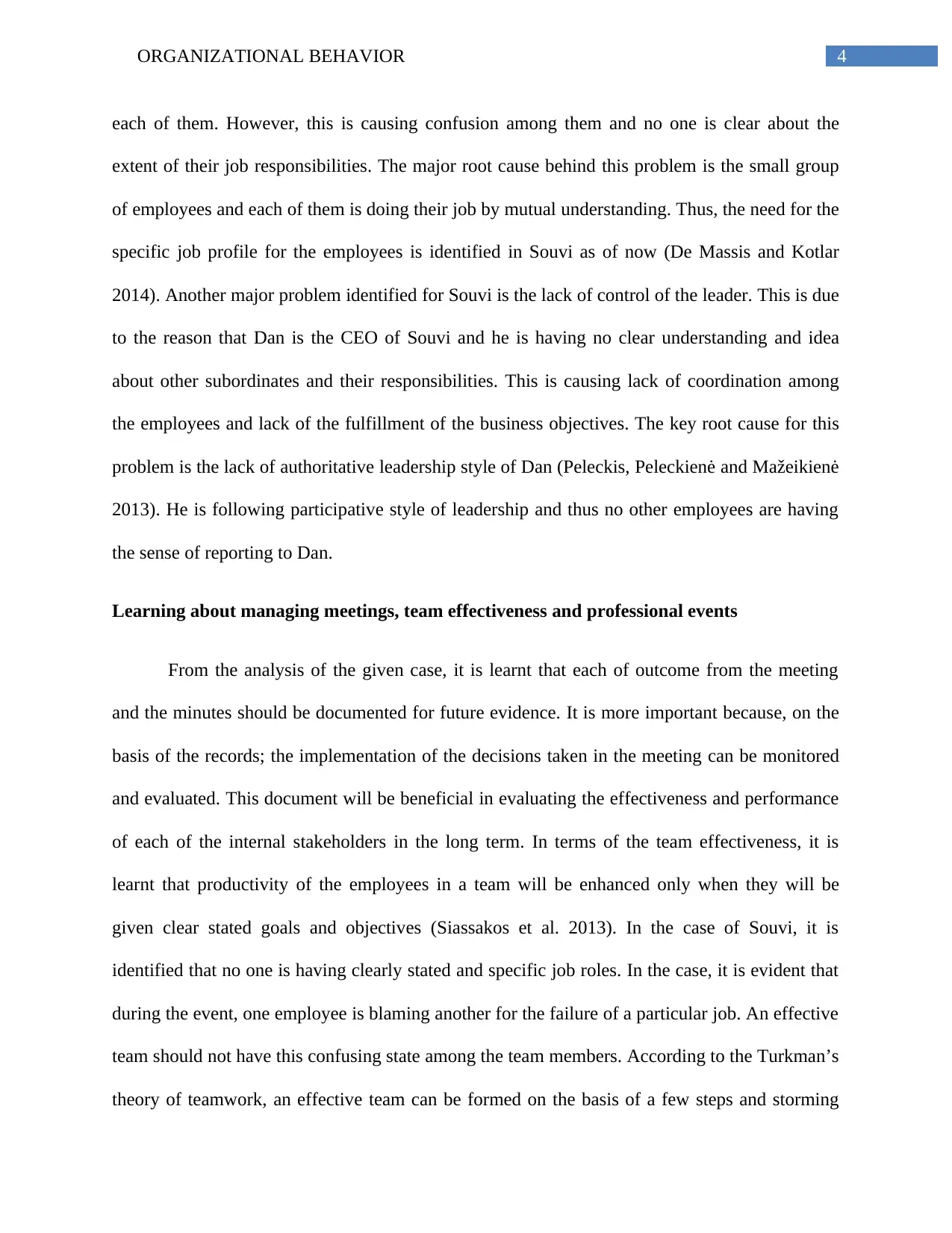
4ORGANIZATIONAL BEHAVIOR
each of them. However, this is causing confusion among them and no one is clear about the
extent of their job responsibilities. The major root cause behind this problem is the small group
of employees and each of them is doing their job by mutual understanding. Thus, the need for the
specific job profile for the employees is identified in Souvi as of now (De Massis and Kotlar
2014). Another major problem identified for Souvi is the lack of control of the leader. This is due
to the reason that Dan is the CEO of Souvi and he is having no clear understanding and idea
about other subordinates and their responsibilities. This is causing lack of coordination among
the employees and lack of the fulfillment of the business objectives. The key root cause for this
problem is the lack of authoritative leadership style of Dan (Peleckis, Peleckienė and Mažeikienė
2013). He is following participative style of leadership and thus no other employees are having
the sense of reporting to Dan.
Learning about managing meetings, team effectiveness and professional events
From the analysis of the given case, it is learnt that each of outcome from the meeting
and the minutes should be documented for future evidence. It is more important because, on the
basis of the records; the implementation of the decisions taken in the meeting can be monitored
and evaluated. This document will be beneficial in evaluating the effectiveness and performance
of each of the internal stakeholders in the long term. In terms of the team effectiveness, it is
learnt that productivity of the employees in a team will be enhanced only when they will be
given clear stated goals and objectives (Siassakos et al. 2013). In the case of Souvi, it is
identified that no one is having clearly stated and specific job roles. In the case, it is evident that
during the event, one employee is blaming another for the failure of a particular job. An effective
team should not have this confusing state among the team members. According to the Turkman’s
theory of teamwork, an effective team can be formed on the basis of a few steps and storming
each of them. However, this is causing confusion among them and no one is clear about the
extent of their job responsibilities. The major root cause behind this problem is the small group
of employees and each of them is doing their job by mutual understanding. Thus, the need for the
specific job profile for the employees is identified in Souvi as of now (De Massis and Kotlar
2014). Another major problem identified for Souvi is the lack of control of the leader. This is due
to the reason that Dan is the CEO of Souvi and he is having no clear understanding and idea
about other subordinates and their responsibilities. This is causing lack of coordination among
the employees and lack of the fulfillment of the business objectives. The key root cause for this
problem is the lack of authoritative leadership style of Dan (Peleckis, Peleckienė and Mažeikienė
2013). He is following participative style of leadership and thus no other employees are having
the sense of reporting to Dan.
Learning about managing meetings, team effectiveness and professional events
From the analysis of the given case, it is learnt that each of outcome from the meeting
and the minutes should be documented for future evidence. It is more important because, on the
basis of the records; the implementation of the decisions taken in the meeting can be monitored
and evaluated. This document will be beneficial in evaluating the effectiveness and performance
of each of the internal stakeholders in the long term. In terms of the team effectiveness, it is
learnt that productivity of the employees in a team will be enhanced only when they will be
given clear stated goals and objectives (Siassakos et al. 2013). In the case of Souvi, it is
identified that no one is having clearly stated and specific job roles. In the case, it is evident that
during the event, one employee is blaming another for the failure of a particular job. An effective
team should not have this confusing state among the team members. According to the Turkman’s
theory of teamwork, an effective team can be formed on the basis of a few steps and storming
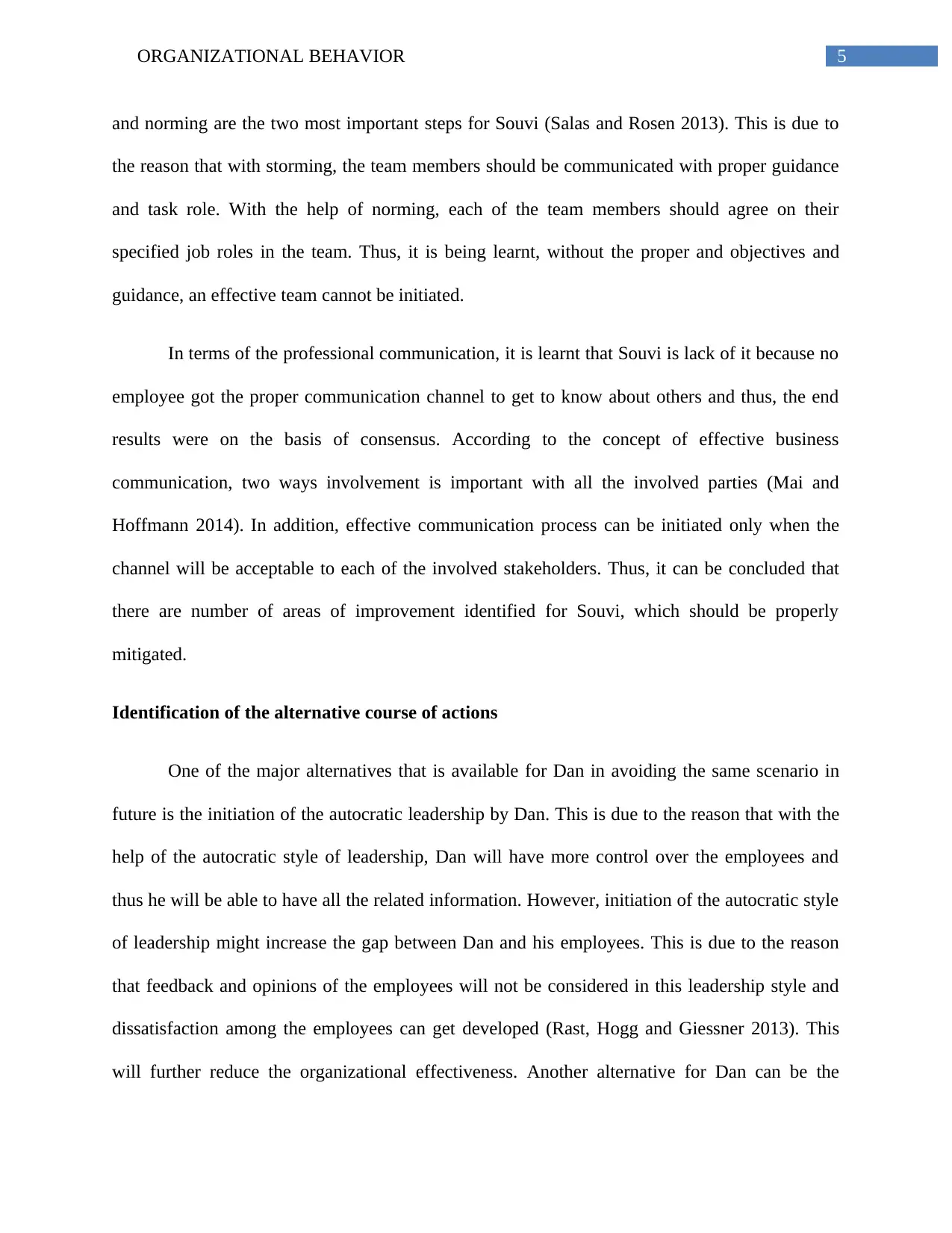
5ORGANIZATIONAL BEHAVIOR
and norming are the two most important steps for Souvi (Salas and Rosen 2013). This is due to
the reason that with storming, the team members should be communicated with proper guidance
and task role. With the help of norming, each of the team members should agree on their
specified job roles in the team. Thus, it is being learnt, without the proper and objectives and
guidance, an effective team cannot be initiated.
In terms of the professional communication, it is learnt that Souvi is lack of it because no
employee got the proper communication channel to get to know about others and thus, the end
results were on the basis of consensus. According to the concept of effective business
communication, two ways involvement is important with all the involved parties (Mai and
Hoffmann 2014). In addition, effective communication process can be initiated only when the
channel will be acceptable to each of the involved stakeholders. Thus, it can be concluded that
there are number of areas of improvement identified for Souvi, which should be properly
mitigated.
Identification of the alternative course of actions
One of the major alternatives that is available for Dan in avoiding the same scenario in
future is the initiation of the autocratic leadership by Dan. This is due to the reason that with the
help of the autocratic style of leadership, Dan will have more control over the employees and
thus he will be able to have all the related information. However, initiation of the autocratic style
of leadership might increase the gap between Dan and his employees. This is due to the reason
that feedback and opinions of the employees will not be considered in this leadership style and
dissatisfaction among the employees can get developed (Rast, Hogg and Giessner 2013). This
will further reduce the organizational effectiveness. Another alternative for Dan can be the
and norming are the two most important steps for Souvi (Salas and Rosen 2013). This is due to
the reason that with storming, the team members should be communicated with proper guidance
and task role. With the help of norming, each of the team members should agree on their
specified job roles in the team. Thus, it is being learnt, without the proper and objectives and
guidance, an effective team cannot be initiated.
In terms of the professional communication, it is learnt that Souvi is lack of it because no
employee got the proper communication channel to get to know about others and thus, the end
results were on the basis of consensus. According to the concept of effective business
communication, two ways involvement is important with all the involved parties (Mai and
Hoffmann 2014). In addition, effective communication process can be initiated only when the
channel will be acceptable to each of the involved stakeholders. Thus, it can be concluded that
there are number of areas of improvement identified for Souvi, which should be properly
mitigated.
Identification of the alternative course of actions
One of the major alternatives that is available for Dan in avoiding the same scenario in
future is the initiation of the autocratic leadership by Dan. This is due to the reason that with the
help of the autocratic style of leadership, Dan will have more control over the employees and
thus he will be able to have all the related information. However, initiation of the autocratic style
of leadership might increase the gap between Dan and his employees. This is due to the reason
that feedback and opinions of the employees will not be considered in this leadership style and
dissatisfaction among the employees can get developed (Rast, Hogg and Giessner 2013). This
will further reduce the organizational effectiveness. Another alternative for Dan can be the
⊘ This is a preview!⊘
Do you want full access?
Subscribe today to unlock all pages.

Trusted by 1+ million students worldwide
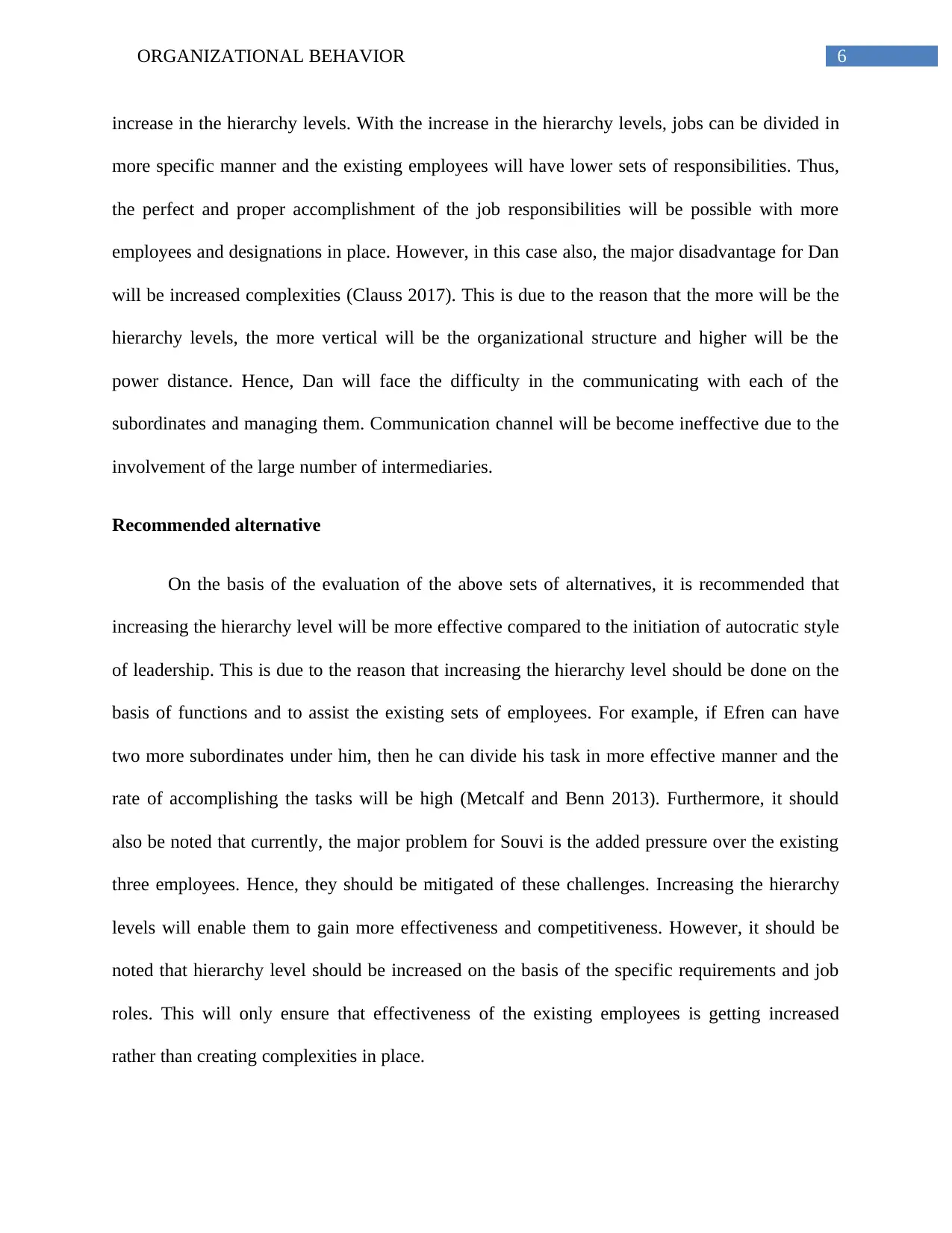
6ORGANIZATIONAL BEHAVIOR
increase in the hierarchy levels. With the increase in the hierarchy levels, jobs can be divided in
more specific manner and the existing employees will have lower sets of responsibilities. Thus,
the perfect and proper accomplishment of the job responsibilities will be possible with more
employees and designations in place. However, in this case also, the major disadvantage for Dan
will be increased complexities (Clauss 2017). This is due to the reason that the more will be the
hierarchy levels, the more vertical will be the organizational structure and higher will be the
power distance. Hence, Dan will face the difficulty in the communicating with each of the
subordinates and managing them. Communication channel will be become ineffective due to the
involvement of the large number of intermediaries.
Recommended alternative
On the basis of the evaluation of the above sets of alternatives, it is recommended that
increasing the hierarchy level will be more effective compared to the initiation of autocratic style
of leadership. This is due to the reason that increasing the hierarchy level should be done on the
basis of functions and to assist the existing sets of employees. For example, if Efren can have
two more subordinates under him, then he can divide his task in more effective manner and the
rate of accomplishing the tasks will be high (Metcalf and Benn 2013). Furthermore, it should
also be noted that currently, the major problem for Souvi is the added pressure over the existing
three employees. Hence, they should be mitigated of these challenges. Increasing the hierarchy
levels will enable them to gain more effectiveness and competitiveness. However, it should be
noted that hierarchy level should be increased on the basis of the specific requirements and job
roles. This will only ensure that effectiveness of the existing employees is getting increased
rather than creating complexities in place.
increase in the hierarchy levels. With the increase in the hierarchy levels, jobs can be divided in
more specific manner and the existing employees will have lower sets of responsibilities. Thus,
the perfect and proper accomplishment of the job responsibilities will be possible with more
employees and designations in place. However, in this case also, the major disadvantage for Dan
will be increased complexities (Clauss 2017). This is due to the reason that the more will be the
hierarchy levels, the more vertical will be the organizational structure and higher will be the
power distance. Hence, Dan will face the difficulty in the communicating with each of the
subordinates and managing them. Communication channel will be become ineffective due to the
involvement of the large number of intermediaries.
Recommended alternative
On the basis of the evaluation of the above sets of alternatives, it is recommended that
increasing the hierarchy level will be more effective compared to the initiation of autocratic style
of leadership. This is due to the reason that increasing the hierarchy level should be done on the
basis of functions and to assist the existing sets of employees. For example, if Efren can have
two more subordinates under him, then he can divide his task in more effective manner and the
rate of accomplishing the tasks will be high (Metcalf and Benn 2013). Furthermore, it should
also be noted that currently, the major problem for Souvi is the added pressure over the existing
three employees. Hence, they should be mitigated of these challenges. Increasing the hierarchy
levels will enable them to gain more effectiveness and competitiveness. However, it should be
noted that hierarchy level should be increased on the basis of the specific requirements and job
roles. This will only ensure that effectiveness of the existing employees is getting increased
rather than creating complexities in place.
Paraphrase This Document
Need a fresh take? Get an instant paraphrase of this document with our AI Paraphraser
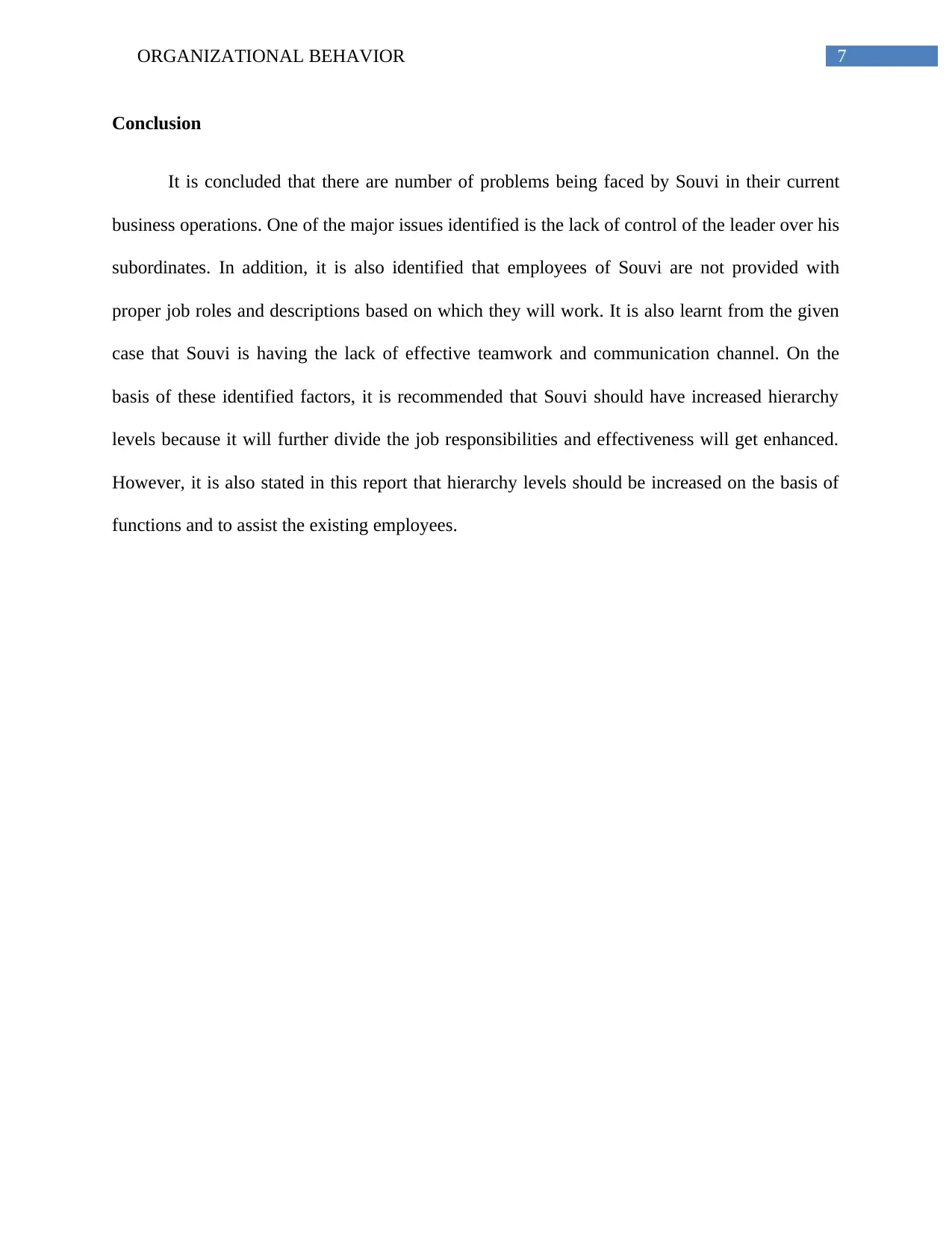
7ORGANIZATIONAL BEHAVIOR
Conclusion
It is concluded that there are number of problems being faced by Souvi in their current
business operations. One of the major issues identified is the lack of control of the leader over his
subordinates. In addition, it is also identified that employees of Souvi are not provided with
proper job roles and descriptions based on which they will work. It is also learnt from the given
case that Souvi is having the lack of effective teamwork and communication channel. On the
basis of these identified factors, it is recommended that Souvi should have increased hierarchy
levels because it will further divide the job responsibilities and effectiveness will get enhanced.
However, it is also stated in this report that hierarchy levels should be increased on the basis of
functions and to assist the existing employees.
Conclusion
It is concluded that there are number of problems being faced by Souvi in their current
business operations. One of the major issues identified is the lack of control of the leader over his
subordinates. In addition, it is also identified that employees of Souvi are not provided with
proper job roles and descriptions based on which they will work. It is also learnt from the given
case that Souvi is having the lack of effective teamwork and communication channel. On the
basis of these identified factors, it is recommended that Souvi should have increased hierarchy
levels because it will further divide the job responsibilities and effectiveness will get enhanced.
However, it is also stated in this report that hierarchy levels should be increased on the basis of
functions and to assist the existing employees.
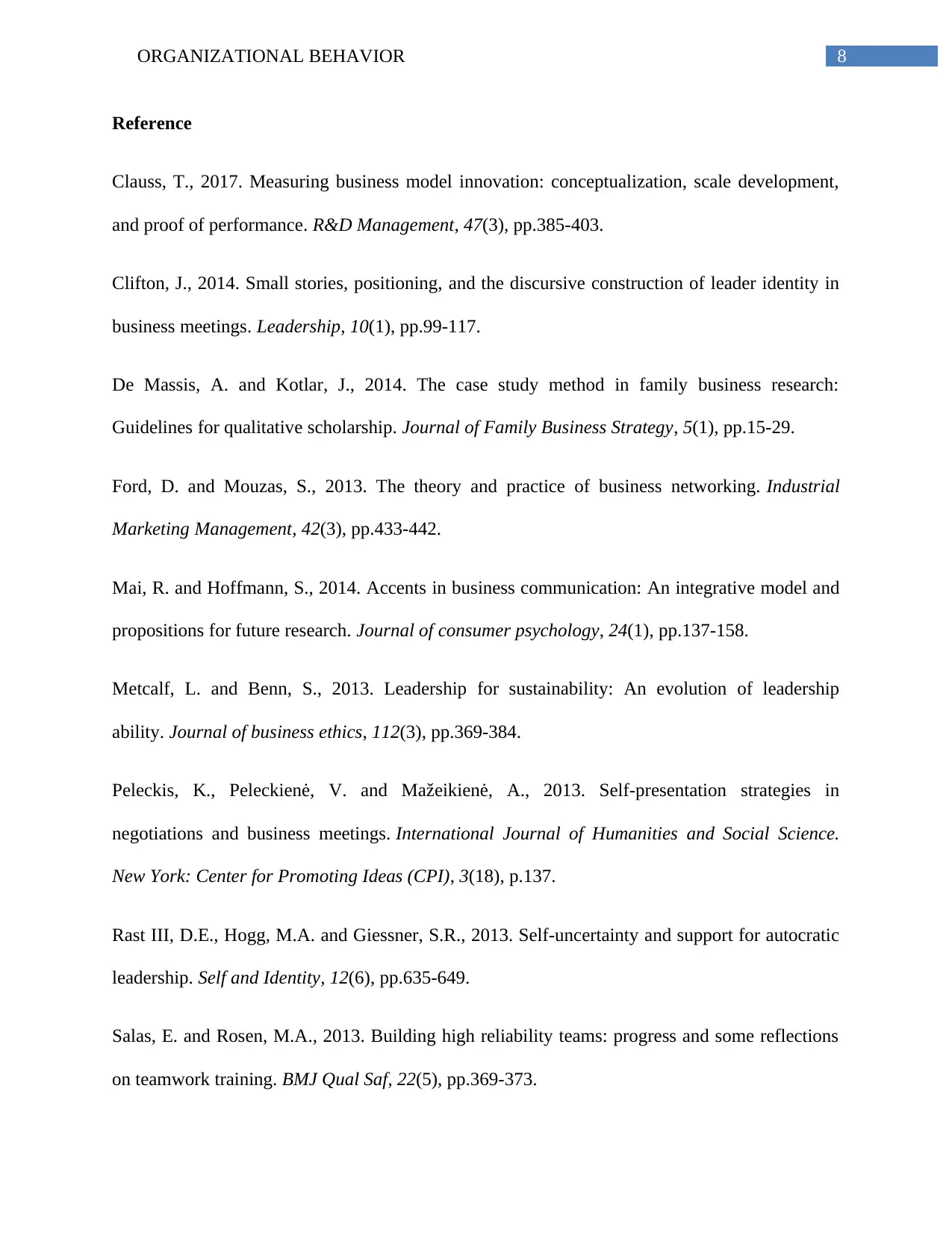
8ORGANIZATIONAL BEHAVIOR
Reference
Clauss, T., 2017. Measuring business model innovation: conceptualization, scale development,
and proof of performance. R&D Management, 47(3), pp.385-403.
Clifton, J., 2014. Small stories, positioning, and the discursive construction of leader identity in
business meetings. Leadership, 10(1), pp.99-117.
De Massis, A. and Kotlar, J., 2014. The case study method in family business research:
Guidelines for qualitative scholarship. Journal of Family Business Strategy, 5(1), pp.15-29.
Ford, D. and Mouzas, S., 2013. The theory and practice of business networking. Industrial
Marketing Management, 42(3), pp.433-442.
Mai, R. and Hoffmann, S., 2014. Accents in business communication: An integrative model and
propositions for future research. Journal of consumer psychology, 24(1), pp.137-158.
Metcalf, L. and Benn, S., 2013. Leadership for sustainability: An evolution of leadership
ability. Journal of business ethics, 112(3), pp.369-384.
Peleckis, K., Peleckienė, V. and Mažeikienė, A., 2013. Self-presentation strategies in
negotiations and business meetings. International Journal of Humanities and Social Science.
New York: Center for Promoting Ideas (CPI), 3(18), p.137.
Rast III, D.E., Hogg, M.A. and Giessner, S.R., 2013. Self-uncertainty and support for autocratic
leadership. Self and Identity, 12(6), pp.635-649.
Salas, E. and Rosen, M.A., 2013. Building high reliability teams: progress and some reflections
on teamwork training. BMJ Qual Saf, 22(5), pp.369-373.
Reference
Clauss, T., 2017. Measuring business model innovation: conceptualization, scale development,
and proof of performance. R&D Management, 47(3), pp.385-403.
Clifton, J., 2014. Small stories, positioning, and the discursive construction of leader identity in
business meetings. Leadership, 10(1), pp.99-117.
De Massis, A. and Kotlar, J., 2014. The case study method in family business research:
Guidelines for qualitative scholarship. Journal of Family Business Strategy, 5(1), pp.15-29.
Ford, D. and Mouzas, S., 2013. The theory and practice of business networking. Industrial
Marketing Management, 42(3), pp.433-442.
Mai, R. and Hoffmann, S., 2014. Accents in business communication: An integrative model and
propositions for future research. Journal of consumer psychology, 24(1), pp.137-158.
Metcalf, L. and Benn, S., 2013. Leadership for sustainability: An evolution of leadership
ability. Journal of business ethics, 112(3), pp.369-384.
Peleckis, K., Peleckienė, V. and Mažeikienė, A., 2013. Self-presentation strategies in
negotiations and business meetings. International Journal of Humanities and Social Science.
New York: Center for Promoting Ideas (CPI), 3(18), p.137.
Rast III, D.E., Hogg, M.A. and Giessner, S.R., 2013. Self-uncertainty and support for autocratic
leadership. Self and Identity, 12(6), pp.635-649.
Salas, E. and Rosen, M.A., 2013. Building high reliability teams: progress and some reflections
on teamwork training. BMJ Qual Saf, 22(5), pp.369-373.
⊘ This is a preview!⊘
Do you want full access?
Subscribe today to unlock all pages.

Trusted by 1+ million students worldwide
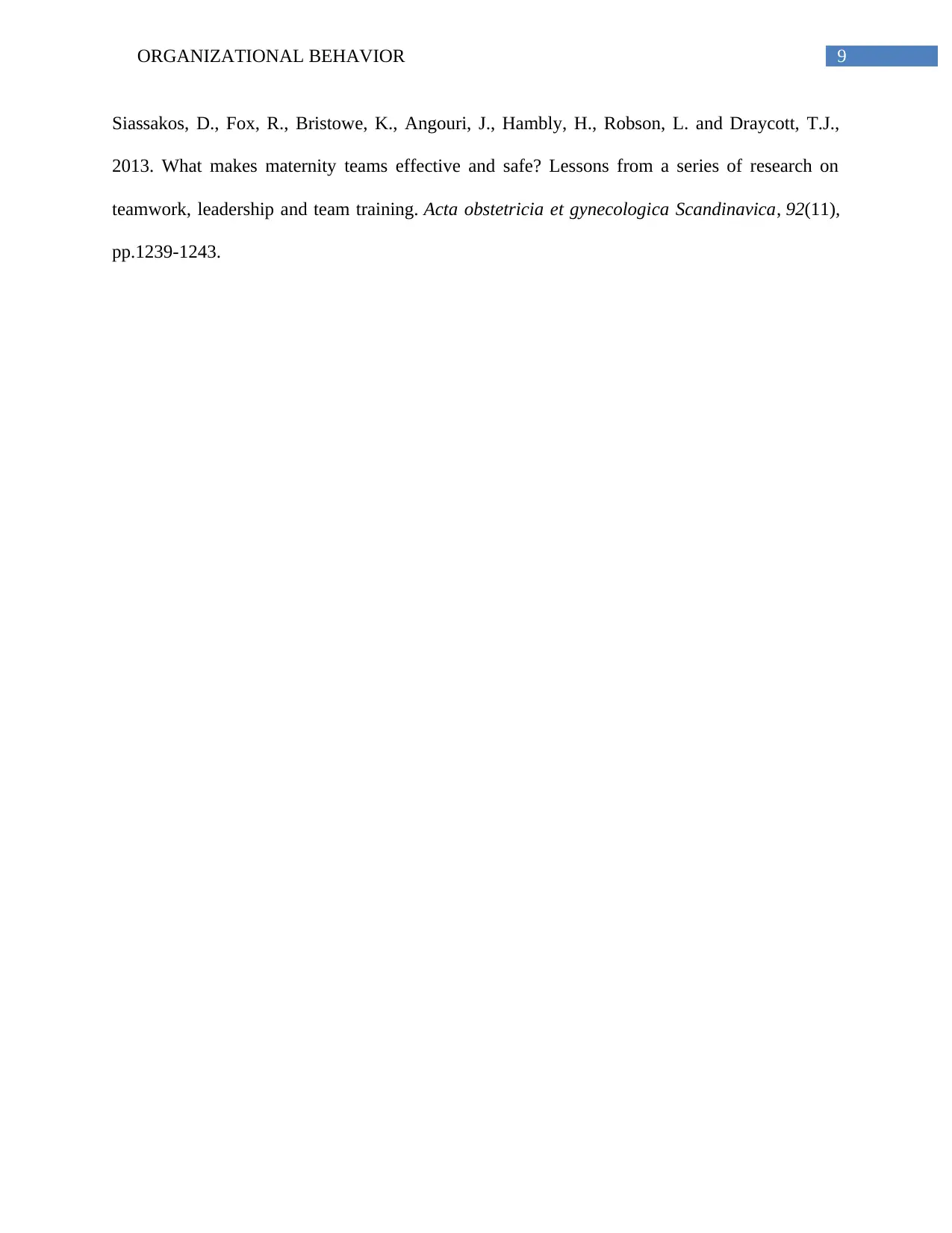
9ORGANIZATIONAL BEHAVIOR
Siassakos, D., Fox, R., Bristowe, K., Angouri, J., Hambly, H., Robson, L. and Draycott, T.J.,
2013. What makes maternity teams effective and safe? Lessons from a series of research on
teamwork, leadership and team training. Acta obstetricia et gynecologica Scandinavica, 92(11),
pp.1239-1243.
Siassakos, D., Fox, R., Bristowe, K., Angouri, J., Hambly, H., Robson, L. and Draycott, T.J.,
2013. What makes maternity teams effective and safe? Lessons from a series of research on
teamwork, leadership and team training. Acta obstetricia et gynecologica Scandinavica, 92(11),
pp.1239-1243.
1 out of 10
Related Documents
Your All-in-One AI-Powered Toolkit for Academic Success.
+13062052269
info@desklib.com
Available 24*7 on WhatsApp / Email
![[object Object]](/_next/static/media/star-bottom.7253800d.svg)
Unlock your academic potential
Copyright © 2020–2025 A2Z Services. All Rights Reserved. Developed and managed by ZUCOL.





